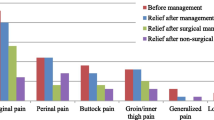Abstract
Introduction and hypothesis
This study aims to report pelvic nerve damage secondary to surgical treatment of pelvic organ prolapse and the role of laparoscopy in the diagnosis and treatment of such nerve damage.
Methods
Ninety-five consecutive patients complaining of pain and/or bladder or bowel dysfunction following surgery for pelvic prolapse underwent laparoscopic exploration for pelvic neuropathy.
Results
A mean reduction in visual analog score (VAS) from 8.9 (±0.96; 6–10) preoperatively to 2.9 (±2.77; 0–6) at 1-year follow-up was obtained in patients after laparoscopic nerve decompression (n = 90; p < 0.001). Success, defined as a reduction in VAS score of greater than 50%, was obtained in 84% of patients. Sixty-five patients (68%) discontinued the regular use of analgesics.
Conclusions
Because secondary nerve damage can appear months or years after the primary procedure, long-term follow-up is mandatory and should focus on nerve damage as well as anatomical and functional outcomes. Laparoscopy is a unique method for etiologic diagnosis and neurosurgical treatment of such nerve lesions through decompression or implantation of an electrode for neuromodulation.



Similar content being viewed by others
References
Verdeja AM, Elkins TE, Odoi A, Gasser R, Lamoutte C (1995) Transvaginal sacrospinous colpopexy: anatomic landmarks to be aware of to minimize complications. Am J Obstet Gynecol 173:1468–1469
Debodinance P, Amblard J, Fatton B, Cosson M, Jacquetin B (2007) The prosthetic kits in the prolapsed surgery: is it a gadget? J Gynecol Obstet Biol Reprod 36(3):267–275
Possover M (2009) Laparoscopic management of endopelvic etiologies of pudendal pain in 134 consecutive patients. J Urol 181:1732–1736
Possover M (2010) New surgical evolutions in management of sacral radiculopathies. Surg Technol Int 19:123–128
Possover M, Rhiem K, Chiantera V (2004) The “laparoscopic neuro-navigation”—LANN: from a functional cartography of the pelvic autonomous neurosystem to a new field of laparoscopic surgery. Min Invas Ther & Allied Technol 13:362–367
Possover M (2004) Laparoscopic exposure and electrostimulation of the somatic and autonomous pelvic nerves: a new method for implantation of neuroprothesis in paralysed patients? J Gynecol Surg Endosc Imaging Allied Tech 1:87–90
Possover M, Baekelandt J, Chiantera V (2007) Anatomy of the sacral roots and the pelvic splanchnic nerves in women using the LANN technique. Surg Lap Endosc Percutan Tech 17(6):508–510
Possover M, Schneider T, Henle KP (2010) Laparoscopic therapy of endometriosis and vascular entrapment of sacral plexus. Fert Steril 95:756–758
Possover M, Baekelandt J, Chiantera V (2007) The laparoscopic implantation of neuroprothesis—LION technique—to control intractable abdomino-pelvic neuralgia. Neuromodulation 10:18–23
Possover M, Baekelandt J, Chiantera V (2007) The laparoscopic approach to control intractable pelvic neuralgia: from laparoscopic pelvic neurosurgery to the LION technique. Clin J Pain 23:821–825
Possover M (2009) Laparoscopic management of neural pelvic pain in women secondary to pelvic surgery. Fertil Steril 91:2720–2725
Shiozawa T, Huebner M, Hirt B, Wallwiener D, Reisenauer C (2010) Nerve-preserving sacrocolpopexy: anatomical study and surgical approach. Eur J Obstet Gynecol Reprod Biol 152(1):103–107
Hamilton Boyles S, Edwards R, Gregory W, Clark A (2007) Complications associated with transobturator sling procedures. Int Urogynecol J 18:19–22
Flynn MK, Weidner AC, Amundsen CL (2006) Sensory nerve injury after uterosacral ligament suspension. Am J Obstet Gynecol 195:1869–1872
Wieslander CK, Roshanravan SM, Wai CY, Schaffer JI, Corton MM (2007) Uterosacral ligament suspension sutures: anatomic relationships in unembalmed female cadavers. Am J Obstet Gynecol 197(6):672.e1–672.e6
Deffieux X, Desseaux K, de Tayrac R, Faivre E, Frydman R, Fernandez H (2009) Infracoccygeal sacropexy for uterovaginal prolapse. Int J Gynaecol Obstet 104(1):56–59
Bjelic-Radisic V, Hartmann G, Abendstein B, Tamussimo K, Riss P (2006) Posterior intravaginal slingplasty (IVS) for prolapse [IUGA abstract 334]. Int Urogynecol J Pelvic Floor Dysfunct 17(suppl 2):S243
Conflicts of interest
None.
Author information
Authors and Affiliations
Corresponding author
Additional information
A related editorial can be found at doi:10.1007/s00192-011-1570-5 and related articles at doi:10.1007/s00192-011-1447-7 and doi:10.1007/s00192-011-1485-1.
Rights and permissions
About this article
Cite this article
Possover, M., Lemos, N. Risks, symptoms, and management of pelvic nerve damage secondary to surgery for pelvic organ prolapse: a report of 95 cases. Int Urogynecol J 22, 1485–1490 (2011). https://doi.org/10.1007/s00192-011-1539-4
Received:
Accepted:
Published:
Issue Date:
DOI: https://doi.org/10.1007/s00192-011-1539-4




